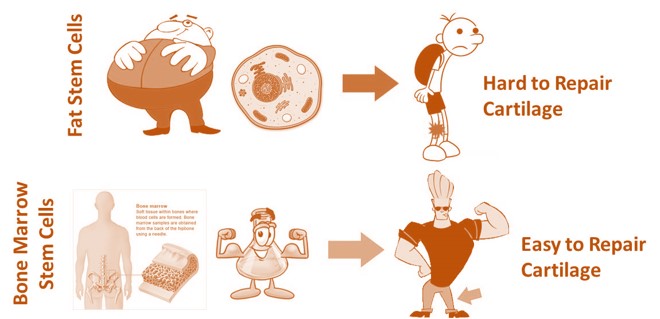Fat Stem Cell Injections and Arthritis: Reality Sets In…
Fat stem cell injections and arthritis? I remember when I first looked into treating patients with stem cells in early 2005. I saw a few papers on fat stem cells and asked the university scientist I was working with what he thought. His team had tested bone marrow versus fat stem cells on athletic horses with arthritis and found that bone marrow was better for orthopedic conditions, so I moved on. Yesterday, I spent some time performing national library of medicine searches to provide input to our Prometheus project. During that few hours I kept running into fat stem cell articles that I didn’t know existed. PubMed (the US National Library of Medicine website) is like that, as there are literally hundreds of millions of papers and slight tweak of a search term can show you articles you didn’t know you didn’t know. However, this trio of articles was so interesting, I just had to share. The summary is that many of the notions on which the nascent fat stem cell industry is based may be seriously flawed.
Fat stem cells have a very seductive business plan. Most Americans have extra pounds they carry and we’d all love to get rid of it the easy way via liposuction. There are stem cells in that fat, so why not bank or use those stem cells elsewhere? Makes sense at face value, but is the science behind the proposition weak? The first paper I ran across was one that showed that the large scale liposuction that surgeons perform to hoover out fat from doesn’t produce good fat stem cells. This is a huge issue, as most fat stem biobanks rely on surgeons who collect fat during common liposuction to provide fat for stem cell isolation and banking. The researchers found that the common liposuction surgery produced cells that were less viable and less functional than a mini-liposuction designed to harvest stem cells. The second paper I ran across is also a problem for fat stem cell fans. In this article, fat stem cells obtained from obese patients were less capable of tissue repair than fat stem cells obtained from normal weight patients. This is a show stopper, as most of the patients seeking fat stem cell treatment for their arthritis are heavier patients. The authors believe the problems is metabolic, meaning heavier patients usually have a metabolic syndrome that involves insulin resistance, which likely causes their stem cells to be less capable of repair. This leads us to the third paper. In this research, the authors found that patients with diabetes (which is the logical successor to a metabolic syndrome) have fat stem cells that are less capable of healing tissue.
The upshot? Some of the basic foundations of the burgeoning fat stem cell industry are on shaky ground. The industrial strength liposuction that’s used to feed fat stem cell biobanks doesn’t produce good fat stem cells. Heavier patients who might want to undergo liposuction and who have more arthritis have cells that are less capable of healing tissue. Finally, heavier patients with diabetes also take another hit to the repair abilities of their cells. To be fair, heavier patients with metabolic syndrome also have less bone marrow stem cell activity. Having said that, the adipose tissue in humans is a reservoir of bad chemicals where many of the fat soluble industrial pollutants live and where many pro-inflammatory cytokines take residence. In addition, while we use fat stem cells from time to time, we always make sure that the more potent bone marrow stem cells (if possible) are used in conjunction with these cells. We also continue to counsel heavy patients with metabolic syndrome or diabetes that while their cells may work fine, all things being equal, they are less active and less potent than the same cells from a patient who is more fit.

If you have questions or comments about this blog post, please email us at [email protected]
NOTE: This blog post provides general information to help the reader better understand regenerative medicine, musculoskeletal health, and related subjects. All content provided in this blog, website, or any linked materials, including text, graphics, images, patient profiles, outcomes, and information, are not intended and should not be considered or used as a substitute for medical advice, diagnosis, or treatment. Please always consult with a professional and certified healthcare provider to discuss if a treatment is right for you.
